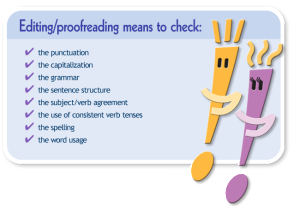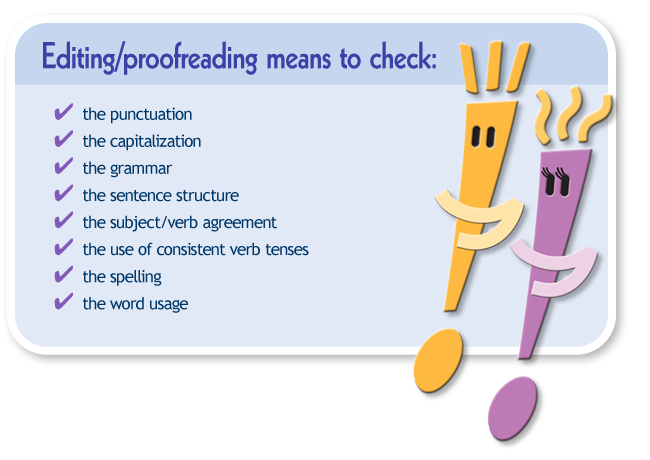 This week I am thinking about different strategies to help me edit my short story: Provocations of Light, currently written as Part 1 and Part 2. As per the picture above, there are many stock activities we can employ to proofread our work. However, being on a Creative Writing course, I wanted to try something more creative and fun.
This week I am thinking about different strategies to help me edit my short story: Provocations of Light, currently written as Part 1 and Part 2. As per the picture above, there are many stock activities we can employ to proofread our work. However, being on a Creative Writing course, I wanted to try something more creative and fun.
Editing Strategy 1 – Sentences of Increasing Length
My self-imposed task is to choose a paragraph and rewrite it in sentences of increasing length: making the first sentence 7 words, the next sentence 14 words, the third sentence 21 words, the fourth sentence 28 words and the final sentence 7 words.
Original Paragraph from my short story Provocations of Light, Part 1 and Part 2
Williams, eyes wide open, stares in disbelief. Slowly, the muffled breathing becomes less desperate. Then a waddle and a movement signifying a stretch, tests the confines of the trap. The layered strips of fine linen crocheted with a faded CGE emblem, dusty and torn, confirm the creature remains hidden in its cocoon. What is she seeing?
Re-worked Paragraph
Williams’ green eyes, flicker with wide-eyed astonishment. Just ahead, a sound of choking slowly simmers, eventually reducing to a muffled restraint. A blurry motion renders it’s form impossible to decipher, as a movement signifying a stretch, tests the confines of the trap. Despite being twisted this way and that, the scaly bandages of fine linen emblazoned with CGE emblem, dusty and torn, confirm the creature remains hidden in its cocoon. What has she caught a glimpse of?
Using this activity in a Language Lesson
The act of collaboratively improving a short piece of writing, a piece penned by the students themselves, can work particularly well in the foreign language classroom. Here’s a quick brainstorm of a basic lesson plan:
Step 1 – T asks the students (ss) to underline the adjectives, and find synonyms by using an online thesaurus.
Step 2 T asks ss to re-write the piece with the newly acquired synonyms
Step 3 – T asks ss to hand the new piece to a partner, who would read through and make comments about the suitability of the new synonyms.
Step 4 – T could board the following questions to aid the discussion:
Do the new synonyms help or hinder your understanding of the paragraph?
Do the new synonyms give new meaning to the paragraph?
Choose 3 words with a new synonym, what are the subtle differences between the original word and the new word?
T monitors and offers individual advice and support, making note of any repeated lexical errors, or miscomprehension.
Step 5 – T gives ss group feedback on common errors or misunderstandings. T may model new words and drill the students individually and chorally.
Step 6 – T asks students in pairs to prepare a short presentation on their partners work.
Step 7 – T asks students in pairs to make a short presentation on their partners work.
Step 8 – T leads a group discussion on the value of writing a second draft, the subtle differences between words and their synonyms and the use of the dictionary and thesaurus for creative writing.
My Thoughts
I used the thesaurus and dictionary to expand my lexical repertoire and I am happy to have more options as I make my way towards a third and final draft of my story. Re-working takes some time though, so this activity would be best carried out with flash fiction stories which are, by nature, short in length. Certainly, the detail seems more rich and precise in my re-worked paragraph. Although in my third sentence, after much head-scratching and staring at the dictionary, even with a re-work, I realise I am not really saying anything new. It’s just extra detail that doesn’t add that much to the story, and, perhaps, could be cut in the final edit. In sum, this activity helps to highlight the sentences which really do add texture to a story, and those which are simply redundant. In doing so, students concurrently develop a different way of talking about their own material, as well as different ways of expressing themselves.


I really like the activity and lesson you have put together here, Karina. This would really emphasise the fact that not all words, even if listed in a thesaurus, can work in the same context. This activity could work well for beginner to advanced language learners as it helps to build vocabulary, while developing the ability to distinguish when and how certain words can be used to express specific things. I also love the fact that it maximises the benefits and rewards of the collaborative process.
Very good idea for a class. I particularly like step 4. This could re-enforce the technique of ‘using details that work’. Another question I would ask the students is: how do the new synonyms add to, not only the sentence, the paragraph, but the whole of the story? What do they tell us about the character, the environment, the situation, the conflict that goes beyond the meaning of that particular word?
Excellent point about deleting words, sentences and even paragraphs. If they do not take the story further, we do not need them. It can be hard, though, to practise detachment to those words that we have selected so carefully. Writing is only for the very brave!